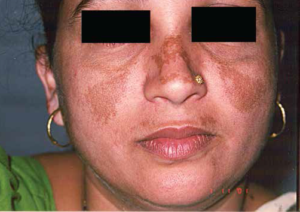
What is Melasma?
Melasma is a common skin condition that causes dark, discolored patches to appear on the face. It is most commonly seen in women, and it often occurs during pregnancy or when taking certain medications that contain hormones. The exact cause of melasma is not well understood, but it is thought to be related to hormonal changes in the body, particularly increased levels of estrogen and progesterone.
What are the predisposing factors for Melasma?
There are several factors that can increase a person’s risk of developing melasma. These include:
-
Being female: Melasma is more common in women, and it is often associated with hormonal changes that occur during pregnancy or when taking certain medications that contain hormones.
-
Having a family history of melasma: If someone in your family has had melasma, you may be more likely to develop it yourself.
-
Having dark skin: Melasma is more common in people with darker skin tones, especially those of Hispanic, Asian, or Middle Eastern descent.
-
Exposure to the sun: Melasma is often triggered by exposure to ultraviolet (UV) light from the sun, so people who spend a lot of time outdoors or who do not use sun protection may be more likely to develop melasma.
-
Taking certain medications: Some medications, such as oral contraceptives and hormone replacement therapy, can increase a person’s risk of developing melasma.
-
Using certain skincare products: Some skincare products, particularly those that contain fragrances or other irritants, may increase a person’s risk of developing melasma.
It is important to note that anyone can develop melasma, regardless of their gender, age, or skin tone. However, some people may be more likely to develop melasma due to the factors mentioned above.
How does Melasma appear ?
The clinical features of melasma vary depending on the individual and the severity of the condition. Some common clinical features of melasma include:
-
Dark, discolored patches of skin on the face: Melasma typically appears on the cheeks, nose, forehead, and upper lip, and it can be symmetrical or asymmetrical. The discolored patches of skin may be tan, brown, or blue-gray in color, and they may be slightly raised.
-
Gradual onset: Melasma often develops gradually over time, and the discolored patches of skin may gradually get darker and more pronounced.
-
Sensitivity to the sun: People with melasma may notice that their symptoms get worse when they are exposed to the sun. This is because UV light from the sun can worsen the appearance of melasma.
-
Persistent symptoms: Melasma can be difficult to treat, and the discolored patches of skin may persist for months or even years. In some cases, melasma may go away on its own, but in many cases it requires ongoing treatment to manage the symptoms.
What is the treatment for Melasma?
Melasma responds poorly to treatment. Generally sun protection measures along with a combination of various treatment modalities (topical, oral, and procedural) is helpful.
Year-round life-long sun protection: Use broad-spectrum very high protection factor (SPF 30+) sunscreen applied to the whole face every
day. It should be reapplied every 2 hours if outdoors during the summer months. Alternatively or as well, use a make-up that contains sunscreen.
Wear a broad-brimmed hat.
Treatment options
- Topical treatments
- Sunscreens
- Skin-lightening agents,
- Chemical peels
- Chemical peels can improve melasma by removing the outermost cells of the skin that contain the pigment. Chemical peels should be undertaken by an experienced dermatologist
- Laser treatment
- Some types of laser also remove the outer layer of skin, whereas others target the pigment-producing cells (melanocytes). The procedure should only be performed by a highly experienced dermatologist.
- Different types of laser therapy have been used including:
- Fractional lasers
- Q-switched Nd:YAG lasers
- PDL
Here are some dos and don’ts for managing melasma:
Do:
- Use sunscreen with an SPF of at least 30 every day, even on cloudy days
- Reapply sunscreen every two hours, or after swimming or sweating
- Wear a hat and protective clothing when outside
- Avoid direct sunlight, especially between the hours of 10 a.m. and 2 p.m.
- Use gentle, fragrance-free skincare products
- Try to reduce stress, as it can worsen melasma
Don’t:
- Don’t Use products that contain irritants, such as alcohol or fragrances
- Don’t Scratch or pick at the patches on your skin
- Don’t Use tanning beds or try to tan your skin, as this can worsen melasma
- Don’t Ignore your symptoms or try to treat them on your own.
